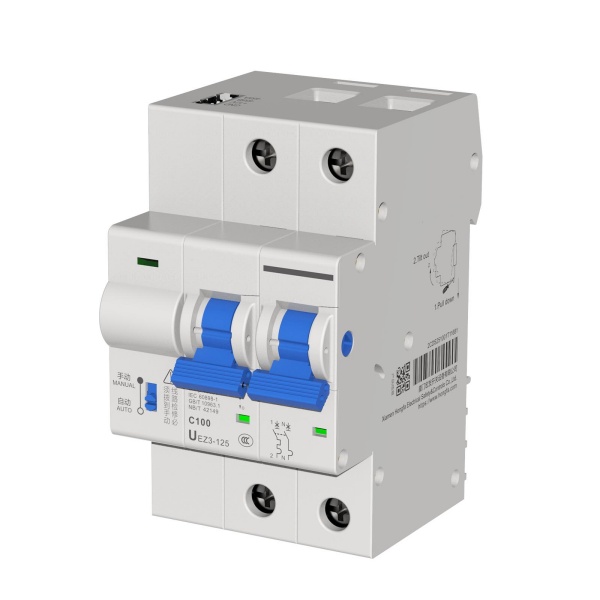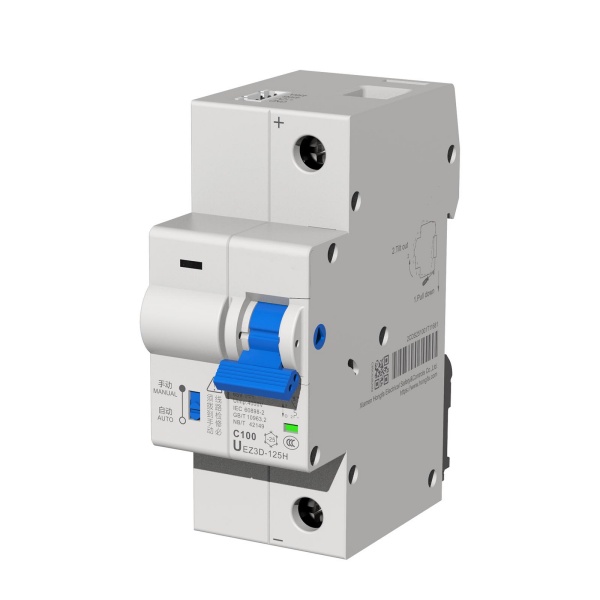In electrical systems, circuit breakers play a vital role. They not only protect circuits from damage caused by overloads and short circuits, but also ensure the stable operation of the system. This article will deeply analyze the key characteristics, working principles and multiple roles of circuit breakers in power systems.

UEZ3-125 Intelligent Miniature Circuit Breaker
Circuit breakers
Circuit breakers are switching devices that can close, carry and break currents under normal circuit conditions, and can close, carry and break currents under abnormal circuit conditions (including short circuit conditions) within a specified time.
Circuit breakers can be used to distribute electrical energy, start asynchronous motors infrequently, and protect power lines and motors. When they have serious overloads or short circuits and undervoltage faults, they can automatically cut off the circuit. Its function is equivalent to a combination of fuse switches and overheating relays. Moreover, it is generally not necessary to change components after breaking the fault current. At present, it has been widely used.
Circuit breakers are generally composed of contact systems, arc extinguishing systems, operating mechanisms, trippers, shells, etc. Circuit breakers are divided into miniature circuit breakers, molded case circuit breakers and frame circuit breakers according to their structure.
Function of circuit breaker
Cut off and connect load circuits, as well as cut off fault circuits, prevent accidents from expanding, and ensure safe operation. High-voltage circuit breakers need to break arcs of 1500V and 1500-2000A. These arcs can be stretched to 2m and continue to burn without extinguishing. Therefore, arc extinguishing is a problem that high-voltage circuit breakers must solve.
Low-voltage circuit breakers are also called automatic air switches. They can be used to connect and disconnect load circuits, and can also be used to control motors that are not frequently started. Its function is equivalent to the sum of some or all functions of electrical appliances such as knife switches, overcurrent relays, undervoltage relays, thermal relays and leakage protectors. It is an important protective electrical appliance in low-voltage distribution networks.
Low-voltage circuit breakers have multiple protection functions (overload, short circuit, undervoltage protection, etc.), adjustable action values, high breaking capacity, easy operation, safety and other advantages, so they are currently widely used. Structure and working principle Low-voltage circuit breakers are composed of operating mechanisms, contacts, protection devices (various trippers), arc extinguishing systems, etc.
Working principle of circuit breaker
When short circuit occurs, the magnetic field generated by large current (generally 10 to 12 times) overcomes the reaction spring, the release pulls the operating mechanism to operate, and the switch trips instantly.
When overloaded, the current becomes larger, the heat generation intensifies, and the bimetallic strip deforms to a certain extent to push the mechanism to operate (the larger the current, the shorter the operation time).
The main contacts of the low-voltage circuit breaker are closed manually or electrically. After the main contacts are closed, the free tripping mechanism locks the main contacts in the closed position. The coil of the overcurrent release and the thermal element of the thermal release are connected in series with the main circuit, and the coil of the undervoltage release is connected in parallel with the power supply. When the circuit is short-circuited or severely overloaded, the armature of the overcurrent release is attracted, causing the free tripping mechanism to operate, and the main contact disconnects the main circuit.
When the circuit is overloaded, the thermal element of the thermal release heats up to bend the bimetallic strip, pushing the free tripping mechanism to operate. When the circuit is undervoltage, the armature of the undervoltage release is released. It also causes the free tripping mechanism to operate. The shunt release is used for remote control. During normal operation, its coil is de-energized. When distance control is required, press the start button to energize the coil, and the armature drives the free tripping mechanism to operate, so that the main contacts are disconnected.
Now there are electronic types, which use mutual inductors to collect the current of each phase and compare it with the set value. When the current is abnormal, the microprocessor sends a signal to drive the electronic release to drive the operating mechanism.
Parameters of circuit breakers
Rated working voltage (Ue): This is the voltage at which the circuit breaker works under normal (uninterrupted) conditions.
Rated current (In): The maximum current value that a circuit breaker equipped with a special overcurrent tripping relay can withstand indefinitely at the ambient temperature specified by the manufacturer, and will not exceed the temperature limit specified by the current-bearing component.
Short-circuit relay tripping current setting value (Im): Short-circuit tripping relays (instantaneous or short-delay) are used to quickly trip the circuit breaker when high fault current values occur. Its tripping limit is Im.
Rated short-circuit breaking capacity (Icu or Icn): The rated short-circuit breaking current of a circuit breaker is the highest (expected) current value that the circuit breaker can break without being damaged.
The current value provided in the standard is the RMS value of the AC component of the fault current. When calculating the standard value, the DC transient component (which always appears under the worst-case short circuit) is assumed to be zero. Industrial circuit breaker ratings (Icu) and household circuit breaker ratings (Icn) are usually given in the form of kA RMS values.
Short-circuit breaking capacity (Ics): The rated breaking capacity of a circuit breaker is divided into two types: rated ultimate short-circuit breaking capacity and rated operating short-circuit breaking capacity.
Conclusion: Through the analysis of low-voltage disconnectors and circuit breakers, we can conclude that although these devices overlap in function, they each have unique application scenarios and advantages. Low-voltage disconnectors are mainly used for circuit separation and combination under no-load current conditions, while circuit breakers have the ability to cut off load and fault currents. The dual power supply transfer switch ensures that the backup power supply can be quickly switched to when the main power supply fails, ensuring the continuity and reliability of power supply. The correct selection and use of these devices is essential to improving the safety and stability of power systems.

Smart DC MCB UEZ3D-125
As a multifunctional protection device, the circuit breaker plays an indispensable role in the power system. Through its ability to automatically cut off the fault current, the circuit breaker not only protects the circuit, but also ensures the safety of personnel. The correct understanding and application of circuit breakers is essential to improving the reliability and safety of power systems.
Post time: 7 月-22-2024


